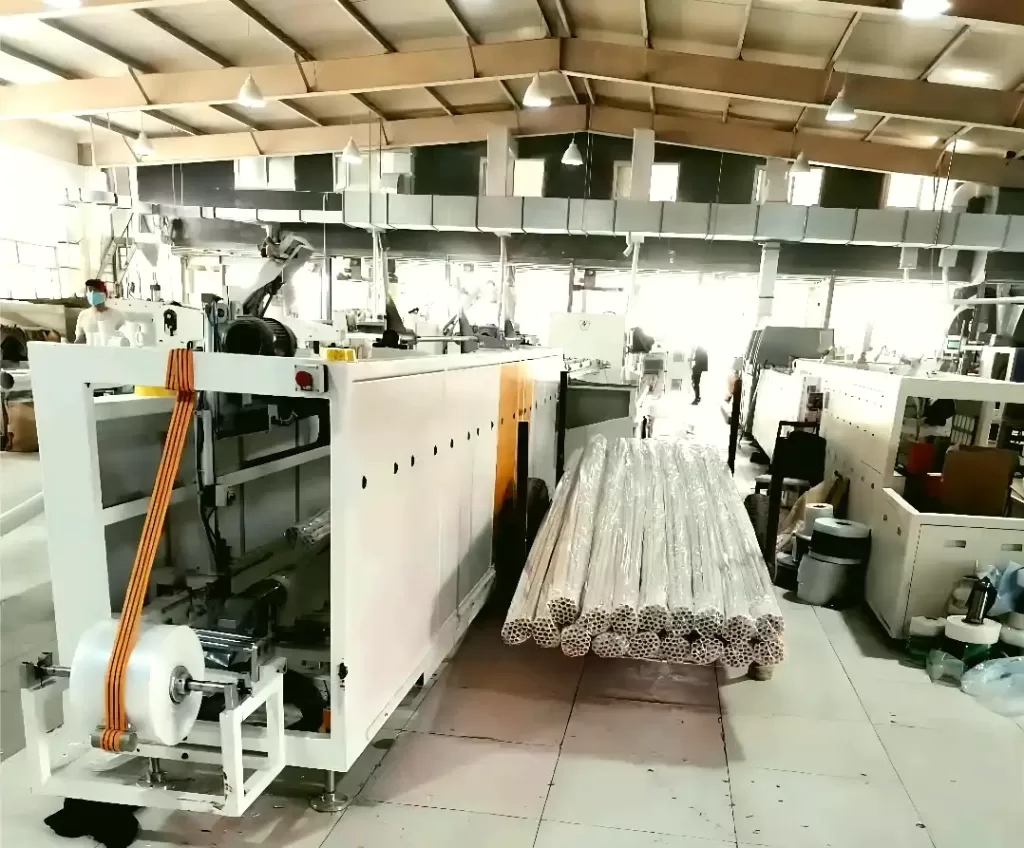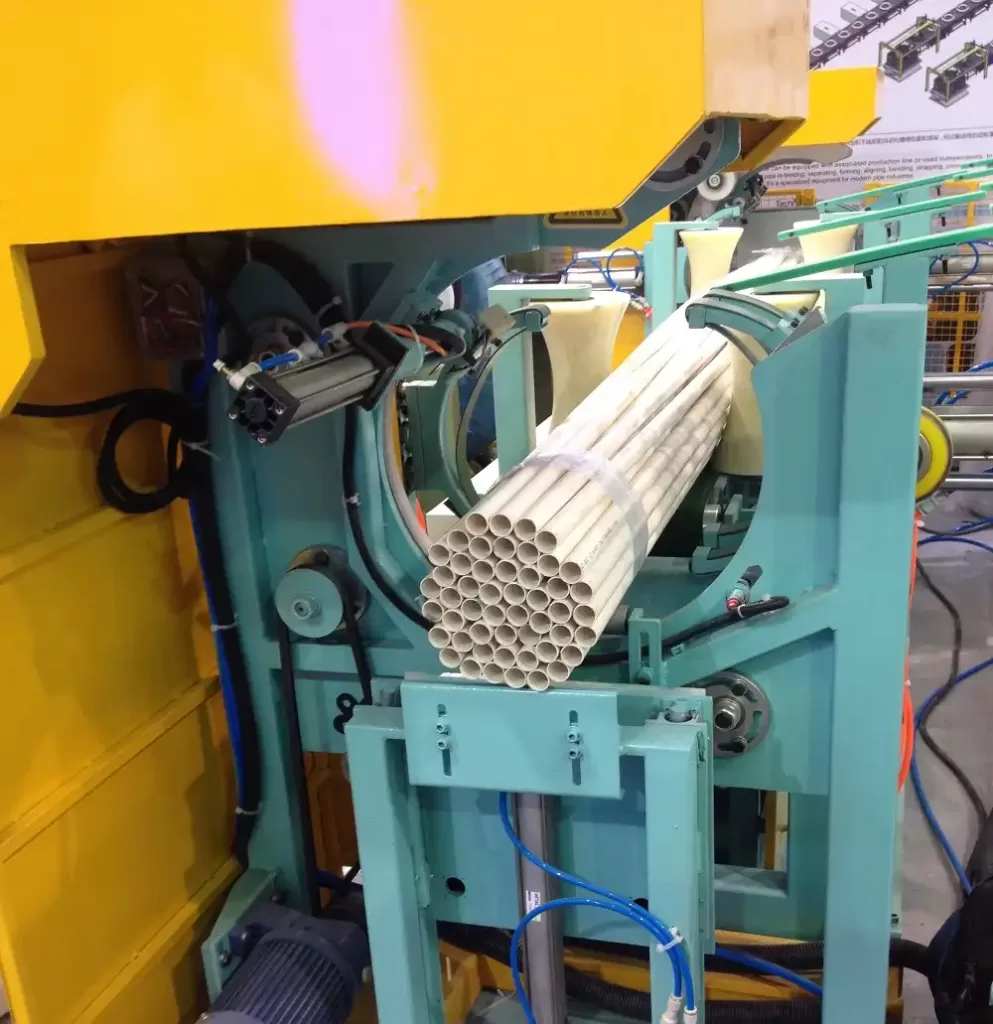Optimizing End-of-Line Operations: Automatic Bundling and Bagging for PVC and Plastic Pipes
Handling and packaging long lengths of extruded materials like PVC or other plastic pipes presents significant logistical challenges for manufacturers. Manual bundling and bagging are often labor-intensive, time-consuming, and can lead to inconsistencies in package quality. Implementing automated systems offers a robust solution to streamline these end-of-line processes, enhancing efficiency and product protection.
Understanding Automatic Pipe Bundling and Bagging Systems
An automatic pipe bundling and bagging system is an integrated production line component designed to efficiently count, gather, secure, and package pipes with minimal human intervention. These systems typically operate downstream from the extrusion cooling and cutting process, preparing pipes for storage or shipment.
The core function involves transitioning individual pipes into neatly organized and protected bundles suitable for handling and transport.
Key Components and Operational Workflow
While specific configurations vary, most automated pipe packaging lines incorporate several key stages:
1. Infeed and Counting
Pipes are received from the upstream process onto an infeed conveyor. Precise counting is critical for accurate bundle formation. This is typically achieved using:
- Photoelectric Sensors: Detect pipes as they pass a specific point.
- Mechanical Counters: Physically actuated counters integrated with the control system.
The system's Programmable Logic Controller (PLC) tracks the count.
2. Bundle Collation and Formation
Once the preset number of pipes is reached (e.g., 6, 10, 19 pipes), they are collected and arranged into the desired bundle configuration. Common shapes include:
- Round
- Square
- Rectangular
- Hexagonal
Specialized jigs or forming stations ensure the pipes are aligned correctly before securing.

3. Strapping or Banding
The formed bundle is then automatically secured using strapping machines. These units apply tensioned plastic straps (typically Polypropylene - PP, or Polyester - PET) around the bundle at predetermined intervals along its length. This keeps the pipes tightly grouped.
4. Bagging or Wrapping (Optional but Common)
For enhanced protection against dust, moisture, scratches, or UV degradation during storage and transit, bundles often undergo a bagging or wrapping stage:
- Bagging: The bundle is inserted into a pre-made polyethylene bag, or a bag is formed around the bundle from a roll of film, then sealed.
- Wrapping: Stretch film or shrink film may be applied around the bundle.
5. Outfeed and Handling
The completed, secured, and potentially bagged bundle is transferred via automated conveyors to a collection area or prepared for removal. Integration with lifting devices or stackers can facilitate pickup by forklifts or overhead cranes.
Control Systems and Technology
Modern pipe bundling lines rely on sophisticated control systems for reliable operation:
- PLC (Programmable Logic Controller): The brain of the system, managing sequences, timing, sensor inputs, and actuator outputs.
- HMI (Human-Machine Interface): Typically a touchscreen panel, allowing operators to set parameters (pipe count, bundle size, strapping locations), monitor system status, receive alerts, and perform diagnostics. Machine failure alarms are clearly displayed for quick troubleshooting.
- Sensors: Photoelectric, proximity, and limit switches monitor pipe presence, bundle position, and machine component status throughout the process.
Benefits of Automated Pipe Packaging
Transitioning from manual to automated pipe bundling and bagging offers several operational advantages:
- Increased Throughput: Automation significantly speeds up the packaging process compared to manual methods.
- Consistent Quality: Ensures uniform bundle shapes, strap tension, and protective wrapping for every bundle.
- Reduced Labor Costs: Frees up personnel from repetitive manual tasks for deployment in other areas.
- Improved Worker Safety: Minimizes manual handling of potentially long, heavy, or awkward pipe bundles.
- Enhanced Product Protection: Reduces the risk of scratches, contamination, or damage during handling and storage.
- Optimized Material Usage: Precise control over strapping and film application can reduce material waste.

automatic pipe bundle strapping machine Applications Across Pipe Types
While frequently implemented for PVC and PPR pipes used in plumbing and construction, these automated packaging principles are adaptable to various tubular products, including:
- Steel Pipes
- Stainless Steel Tubes
- Copper Pipes
- Aluminum Tubes
- Other Plastic Profiles
The system can be configured to handle different diameters, lengths, and material characteristics. For manufacturers exploring specific configurations, understanding the options for an Automatic Bundling Machine and Bagging Machine for PVC Pipe or Plastic Pipe is a key step.
Conclusion
Automated bundling and bagging systems provide pipe manufacturers with a powerful tool to optimize end-of-line efficiency, ensure consistent product presentation, and improve overall operational safety. By integrating counting, bundling, strapping, and bagging into a seamless automated process, these systems address key challenges in handling long tubular products, contributing to a more productive and competitive manufacturing environment.